Histopathological and Functional Evaluation of Radiation-Induced Sciatic Nerve Damage: Melatonin as Radioprotector
Abstract
:1. Introduction
2. Methods
2.1. Animals
2.2. Experimental Design
2.3. Irradiation
2.4. Drug Administration
2.5. Sciatic Nerve Function Index (SFI)
2.6. Histopathological Examination
2.7. Statistical Analysis
3. Results
3.1. Functional Assessment
3.2. Histopathological Evaluation
3.3. Axon and Myelin Sheath Diameter
4. Discussion
5. Conclusions
Author Contributions
Funding
Conflicts of Interest
References
- Halperin, E.C.; Brady, L.W.; Perez, C.A.; Wazer, D.E. Perez & Brady’s Principles and Practice of Radiation Oncology; Lippincott Williams & Wilkins: Philadelphia, PA, USA, 2013. [Google Scholar]
- Delanian, S.; Lefaix, J.L.; Pradat, P.F. Radiation-induced neuropathy in cancer survivors. Radiother Oncol. 2012, 105, 273–282. [Google Scholar] [CrossRef] [PubMed] [Green Version]
- Gikas, P.D.; Hanna, S.A.; Aston, W.; Kalson, N.S.; Tirabosco, R.; Saifuddin, A.; Cannon, S.R. Post-radiation sciatic neuropathy: A case report and review of the literature. World J. Surg. Oncol. 2008, 6, 130. [Google Scholar] [CrossRef] [PubMed]
- Gosk, J.; Rutowski, R.; Reichert, P.; Rabczyński, J. Radiation-induced brachial plexus neuropathy–aetiopathogenesis, risk factors, differential diagnostics, symptoms and treatment. Folia Neuropathol. 2007, 45, 26–30. [Google Scholar] [PubMed]
- Zhang, B.; Su, Y.; Ai, G.; Wang, Y.; Wang, T.; Wang, F. Involvement of peroxiredoxin I in protecting cells from radiation-induced death. J. Radiat. Res. 2005, 46, 305–312. [Google Scholar] [CrossRef] [PubMed]
- Mansour, H.H.; Hafez, H.F.; Fahmy, N.M.; Hanafi, N. Protective effect of N-acetylcysteine against radiation induced DNA damage and hepatic toxicity in rats. Biochem. Pharmacol. 2008, 75, 773–780. [Google Scholar] [CrossRef]
- Gillette, E.; Mahler, P.; Powers, B.; Gillette, S.; Vujaskovic, Z. Late radiation injury to muscle and peripheral nerves. Int. J. Radiat. Oncol. Biol. Phys. 1995, 31, 1309–1318. [Google Scholar] [CrossRef]
- Mendes, D.; Nawalkar, R.; Eldar, S. Post-irradiation femoral neuropathy. A case report. JBJS 1991, 73, 137–140. [Google Scholar] [CrossRef]
- Emami, B.; Lyman, J.; Brown, A.; Cola, L.; Goitein, M.; Munzenrider, J.; Shank, B.; Solin, L.; Wesson, M. Tolerance of normal tissue to therapeutic irradiation. Int. J. Radiat. Oncol. Biol. Phys. 1991, 21, 109–122. [Google Scholar] [CrossRef]
- Gunderson, L.L.; Nelson, H.; Martenson, J.A.; Cha, S.; Haddock, M.; Devine, R.; Fieck, J.M.; Wolff, B.; Dozois, R.; O’Connell, M.J. Locally advanced primary colorectal cancer: Intraoperative electron and external beam irradiation±5-FU. Int. J. Radiat. Oncol. Biol. Phys. 1997, 37, 601–614. [Google Scholar] [CrossRef]
- Birben, E.; Sahiner, U.M.; Sackesen, C.; Erzurum, S.; Kalayci, O. Oxidative stress and antioxidant defense. World Allergy Organ J. 2012, 5, 9. [Google Scholar] [CrossRef] [PubMed]
- Chevion, S.; Or, R.; Berry, E.M. The antioxidant status of patients subjected to today body irradiation. IUBMB Life 1999, 47, 1019–1027. [Google Scholar] [CrossRef]
- Taysi, S.; Uslu, C.; Akcay, F.; Sutbeyaz, M.Y. Malondialdehyde and nitric oxide levels in the plasma of patients with advanced laryngeal cancer. Surg. Today 2003, 33, 651–654. [Google Scholar] [CrossRef]
- Halliwell, B. Antioxidants in human health and disease. Annu. Rev. Nutr. 1996, 16, 33–50. [Google Scholar] [CrossRef]
- Victor, V.M.; McCreath, K.J.; Rocha, M. Recent progress in pharmacological research of antioxidants in pathological conditions: Cardiovascular health. Recent Pat. Anti-Infect. Drug Discov. 2006, 1, 17–31. [Google Scholar] [CrossRef]
- Shirazi, A.; Ghobadi, G.; Ghazi-Khansari, M. A radiobiological review on melatonin: A novel radioprotector. J. Radiat. Res. 2007, 48, 263–272. [Google Scholar] [CrossRef]
- Karbownik, M.; Reiter, R.J. Antioxidative effects of melatonin in protection against cellular damage caused by ionizing radiation. Proc. Soc. Exp. Biol. Med. 2000, 225, 9–22. [Google Scholar] [CrossRef] [PubMed]
- Shabeeb, D.; Keshavarz, M.; Shirazi, A.; Hassanzadeh, G.; Hadian, M.; Nowrouzi, A.; Najafi, M.; Musa, A. Evaluation of the radioprotective effects of melatonin against ionizing radiation-induced muscle tissue injury. Curr. Radiopharm. 2019. [Google Scholar] [CrossRef]
- Shabeeb, D.; Najafi, M.; Musa, A.E.; Keshavarz, M.; Shirazi, A.; Hassanzadeh, G.; Hadian, M.R.; Samandari, H. Biochemical and Histopathological Evaluation of the Radioprotective Effects of Melatonin Against Gamma Ray-Induced Skin Damage. Curr. Radiopharm. 2019, 12, 72–81. [Google Scholar] [CrossRef]
- Öhrnel, L.-O.; Brånemark, R.; Nyman, J.; Nilsso, P.; Thomsen, P. Effects of Irradiation on the Biomechanics of Osseointegration: An Experimental in Vivo Study in Rats. Scand. J. Plast. Reconstr. Surg. Hand Surg. 1997, 31, 281–293. [Google Scholar] [CrossRef]
- Daglioglu, E.; Dike, M.S.; Kilinc, K.; Erdogan, D.; Take, G.; Ergüngör, F.; Okay, O.; Bıyıklı, Z. Neuroprotective Effect of Melatonin on Experimental Peripheral Nerve Injury: An Electron Microscopic and Biochemical Study. Central. Eur. Neurosurg. 2009, 70, 109–114. [Google Scholar] [CrossRef] [PubMed]
- Atik, B.; Erkutlu, I.; Tercan, M.; Buyukhatipoglu, H.; Bekerecioglu, M.; Pence, S. The effects of exogenous melatonin on peripheral nerve regeneration and collagen formation in rats. J. Surg. Res. 2011, 166, 330–336. [Google Scholar] [CrossRef] [PubMed]
- Shirazi, A.; Haddadi, G.; Minaee, B.; Sepehrizadeh, Z.; Mahdavi, S.R.; Jaberi, E.; Haddadi, M. Evaluation of melatonin for modulation of apoptosis-related genes in irradiated cervical spinal cord. Int. J. Low Radiat. 2010, 7, 436. [Google Scholar] [CrossRef]
- Vijayalaxmi, R.R.J.; Tan, D.-X.; Herman, T.S.; Thomas, C.R. Melatonin as a radioprotective agent: A review. Int. J. Radiat. Oncol. 2004, 59, 639–653. [Google Scholar] [CrossRef] [PubMed]
- Slominski, A.; Tobin, D.J.; Zmijewski, M.A.; Wortsman, J.; Paus, R. Melatonin in the skin: Synthesis, metabolism and functions. Trends Endocrinol. Metab. 2008, 19, 17–24. [Google Scholar] [CrossRef] [PubMed]
- Fischer, T.W.; Slominski, A.; Zmijewski, M.A.; Reiter, R.J.; Paus, R. Melatonin as a major skin protectant: From free radical scavenging to DNA damage repair. Exp. Dermatol. 2008, 17, 713–730. [Google Scholar] [CrossRef] [PubMed]
- Reiter, R.J.; Tan, D.; Manchester, L.C.; Qi, W. Biochemical reactivity of melatonin with reactive oxygen and nitrogen species. Cell Biochem. Biophys. 2001, 34, 237–256. [Google Scholar] [CrossRef]
- De Medinaceli, L.; Freed, W.J.; Wyatt, R.J. An index of the functional condition of rat sciatic nerve based on measurements made from walking tracks. Exp. Neurol. 1982, 77, 634–643. [Google Scholar] [CrossRef]
- Bain, J.R.; MacKinnon, S.E.; Hunter, D.A. Functional Evaluation of Complete Sciatic, Peroneal, and Posterior Tibial Nerve Lesions in the Rat. Plast. Reconstr. Surg. 1989, 83, 137–138. [Google Scholar] [CrossRef]
- Carlton, J. Quantitating integrated muscle function following reinnervation. Surg Forum. 1979, 37, 611–612. [Google Scholar]
- Shirazi, A.; Hadadi, G.H.; Ghazi, K.M.; Abou, A.F.; Mahdavi, S.R.; Eshraghian, M. Evaluation of melatonin for prevention of radiation myelopathy in irradiated cervical spinal cord. Cell J. 2009, 11, 43–48. [Google Scholar]
- Rose, T.; Garcia, E.; Bachand, F.; Kim, D.; Petrik, D.; Halperin, R.; Crook, J. QOL Comparison of Acute Side Effects From a High Dose Rate Vs. Low Dose Rate Prostate Brachytherapy Boost Combined With External Beam Radiotherapy. Brachytherapy 2015, 14, S36. [Google Scholar] [CrossRef] [Green Version]
- Savard, J.; Ivers, H.; Savard, M.H.; Morin, C.M. Cancer treatments and their side effects are associated with aggravation of insomnia: Results of a longitudinal study. Cancer 2015, 121, 1703–1711. [Google Scholar] [CrossRef]
- Johansson, S.; Svensson, H.; Larsson, L.G.; Denekamp, J. Brachial plexopathy after postoperative radiotherapy of breast cancer patients: A long-term follow-up. Acta Oncol. 2000, 39, 373–382. [Google Scholar] [CrossRef] [PubMed]
- Killer, H.; Hess, K. Natural history of radiation-induced brachial plexopathy compared with surgically treated patients. J. Neurol. 1990, 237, 247–250. [Google Scholar] [CrossRef] [PubMed]
- Calvo, W.; Forteza-Vila, J. Glycogen changes in bone marrow nerves after whole-body x-irradiation. Acta Neuropathol. 1972, 20, 78–83. [Google Scholar] [CrossRef] [PubMed]
- Match, R.M. Radiation-induced brachial plexus paralysis. Arch. Surg. 1975, 110, 384–386. [Google Scholar] [CrossRef] [PubMed]
- Mondrup, K.; Olsen, N.; Pfeiffer, P.; Rose, C. Clinical and electrodiagnostic findings in breast cancer patients with radiation-induced brachial plexus neuropathy. Acta Neurol. Scand. 1990, 81, 153–158. [Google Scholar] [CrossRef] [PubMed]
- Pierce, S.M.; Recht, A.; Lingos, T.I.; Abner, A.; Vicini, F.; Silver, B.; Herzog, A.; Harris, J.R. Long-term radiation complications following conservative surgery (CS) and radiation therapy (RT) in patients with early stage breast cancer. Int. J. Radiat. Oncol. Biol. Phys. 1992, 23, 915–923. [Google Scholar] [CrossRef]
- Kinsella, T.J.; Deluca, A.M.; Barnes, M.; Anderson, W.; Terrill, R.; Sindelar, W.F. Threshold dose for peripheral neuropathy following intraoperative radiotherapy (IORT) in a large animal model. Int. J. Radiat. Oncol. Biol. Phys. 1991, 20, 697–701. [Google Scholar] [CrossRef]
- Vujaskovic, Z.; Gillette, S.; Powers, B.; LaRue, S.; Gillette, E.; Borak, T.; Scott, R.; Colacchio, T. Intraoperative radiation (IORT) injury to sciatic nerve in a large animal model. Radiother. Oncol. 1994, 30, 133–139. [Google Scholar] [CrossRef]
- Scaravilli, F.; Love, S.; Myers, R. X-irradiation impairs regeneration of peripheral nerve across a gap. J. Neurocytol. 1986, 15, 439–449. [Google Scholar] [CrossRef]
- Stearns, M. The effect of irradiation on nerve grafting. Clin. Otolaryngol. 1982, 7, 161–164. [Google Scholar] [CrossRef]
- Brandt, K.; Evans, G.R.; Gürlek, A.; Savel, T.; Lohman, R.; Nabawi, A.; Williams, J.; Patrick, C.W.; Ang, K.K.; Lembo, T. The effects of preoperative irradiation on peripheral nerve regeneration. Ann. Plast. Surg. 1998, 40, 277–282. [Google Scholar] [CrossRef] [PubMed]
- Powell, S.; Cooke, J.; Parsons, C. Radiation-induced brachial plexus injury: Follow-up of two different fractionation schedules. Radiother. Oncol. 1990, 18, 213–220. [Google Scholar] [CrossRef]
- Johansson, S.; Svensson, H.; Denekamp, J. Dose response and latency for radiation-induced fibrosis, edema, and neuropathy in breast cancer patients. Int. J. Radiat. Oncol. Biol. Phys. 2002, 52, 1207–1219. [Google Scholar] [CrossRef]
- Bae, Y.S.; Oh, H.; Rhee, S.G.; Do Yoo, Y. Regulation of reactive oxygen species generation in cell signaling. Mol. Cells. 2011, 32, 491–509. [Google Scholar] [PubMed] [Green Version]
- Allison, R.; Dicker, A. Minimizing morbidity in radiation oncology: A special issue from Future Oncology. Future Oncol. 2014, 10, 2303–2305. [Google Scholar] [CrossRef]
- Najafi, M.; Motevaseli, E.; Shirazi, A.; Geraily, G.; Rezaeyan, A.; Norouzi, F.; Rezapoor, S.; Abdollahi, H. Mechanisms of inflammatory responses to radiation and normal tissues toxicity: Clinical implications. Int. J. Radiat. Biol. 2018, 94, 335–356. [Google Scholar] [CrossRef]
- Ghobadi, A.; Shirazi, A.; Najafi, M.; Kahkesh, M.H.; Rezapoor, S. Melatonin ameliorates radiation-induced oxidative stress at targeted and nontargeted lung tissue. J. Med. Phys. 2017, 42, 241. [Google Scholar]
- Shabeeb, D.; Najafi, M.; Keshavarz, M.; Musa, A.E.; Hassanzadeh, G.; Hadian, M.R.; Shirazi, A.; Kashavarz, M.; Hasanzadeh, G. Recent Finding in Repair of the Peripheral Nerve Lesions Using Pharmacological Agents: Common Methods for Evaluating the Repair Process. Central. Nerv. Syst. Agents Med. Chem. 2018, 18, 161–172. [Google Scholar] [CrossRef]
- Sinha, K.; Degaonkar, M.N.; Jagannathan, N.R.; Gupta, Y.K. Effect of melatonin on ischemia reperfusion injury induced by middle cerebral artery occlusion in rats. Eur. J. Pharmacol. 2001, 428, 185–192. [Google Scholar] [CrossRef]
- Kondoh, T.; Uneyama, H.; Nishino, H.; Torii, K. Melatonin reduces cerebral edema formation caused by transient forebrain ischemia in rats. Life Sci. 2002, 72, 583–590. [Google Scholar] [CrossRef]
- Musa, A.E.; Shabeeb, D. Radiation-Induced Heart Diseases: Protective Effects of Natural Products. Medicina 2019, 55, 126. [Google Scholar] [CrossRef]
- Erol, F.S.; Kaplan, M.; Tiftikci, M.; Yakar, H.; Ozercan, I.; Ilhan, N.; Topsakal, C. Comparison of the effects of octreotide and melatonin in preventing nerve injury in rats with experimental spinal cord injury. J. Clin. Neurosci. 2008, 15, 784–790. [Google Scholar] [CrossRef]
- Yahyapour, R.; Shabeeb, D.; Cheki, M.; Musa, A.E.; Farhood, B.; Rezaeyan, A.; Amini, P.; Fallah, H.; Najafi, M. Radiation Protection and Mitigation by Natural Antioxidants and Flavonoids: Implications to Radiotherapy and Radiation Disasters. Curr. Mol. Pharmacol. 2018, 11, 285–304. [Google Scholar] [CrossRef] [Green Version]
- Sarikcioglu, L.; Demirel, B.M.; Utuk, A. Walking track analysis: An assessment method for functional recovery after sciatic nerve injury in the rat. Folia Morphol. 2009, 68, 1–7. [Google Scholar]
- Kaya, Y.; Savas, K.; Sarikcioglu, L.; Yaras, N.; Angelov, D.N. Melatonin leads to axonal regeneration, reduction in oxidative stress, and improved functional recovery following sciatic nerve injury. Curr. Neurovascular Res. 2015, 12, 53–62. [Google Scholar] [CrossRef]
- Yanilmaz, M.; Akduman, D.; Sagun, Ö.F.; Haksever, M.; Yazicilar, O.; Orhan, I.; Akpolat, N.; Gök, U. The effects of aminoguanidine, methylprednisolone, and melatonin on nerve recovery in peripheral facial nerve neurorrhaphy. J. Craniofac. Surg. 2015, 26, 667–672. [Google Scholar] [CrossRef]
- Raimondo, S.; Fornaro, M.; Di Scipio, F.; Ronchi, G.; Giacobini-Robecchi, M.G.; Geuna, S. Methods and protocols in peripheral nerve regeneration experimental research: Part II—Morphological techniques. Int. Rev. Neurobiol. 2009, 87, 81–103. [Google Scholar] [PubMed]
- Hall, E.D.; Braughler, J.M. Effects of intravenous methylprednisolone on spinal cord lipid peroxidation and (Na++ K+)-ATPase activity: Dose-response analysis during 1st hour after contusion injury in the cat. J. Neurosurg. 1982, 57, 247–253. [Google Scholar] [CrossRef]
- Konat, G.W.; Wiggins, R.C. Effect of reactive oxygen species on myelin membrane proteins. J. Neurochem. 1985, 45, 1113–1118. [Google Scholar] [CrossRef]
- Gül, Ş.; Çelik, S.E.; Kalaycı, M.; Taşyürekli, M.; Çokar, N.; Bilge, T. Dose-dependent neuroprotective effects of melatonin on experimental spinal cord injury in rats. Surg. Neurol. 2005, 64, 355–361. [Google Scholar] [CrossRef]
- Alimoradi, H.; Pourmohammadi, N.; Mehr, S.E.; Hassanzadeh, G.; Hadian, M.R.; Sharifzadeh, M.; Bakhtiarian, A.; Dehpour, A.R. Effects of lithium on peripheral neuropathy induced by vincristine in rats. Acta Med. Iran. 2012, 50, 373–379. [Google Scholar]
- Pourmohammadi, N.; Alimoradi, H.; Mehr, S.E.; Hassanzadeh, G.; Hadian, M.R.; Sharifzadeh, M.; Bakhtiarian, A.; Dehpour, A.R. Lithium attenuates peripheral neuropathy induced by paclitaxel in rats. Clin. Pharmacol. Toxicol. 2012, 110, 231–237. [Google Scholar] [CrossRef]
- Musa, A.E.; Shabeeb, D.; Omyan, G. Clinical Applications of Melatonin in Radiotherapy: A Review. SN Compr. Clin. Med. 2019, 1, 575–583. [Google Scholar] [CrossRef]
- Fujimoto, T.; Nakamura, T.; Ikeda, T.; Takagi, K. Potent protective effects of melatonin on experimental spinal cord injury. Spine 2000, 25, 769–775. [Google Scholar] [CrossRef]
- Reiter, R.J. Melatonin: Lowering the high price of free radicals. Physiology 2000, 15, 246–250. [Google Scholar] [CrossRef]
- Salie, R.; Harper, I.; Cillie, C.; Genade, S.; Huisamen, B.; Moolman, J.; Lochner, A. Melatonin protects against ischaemic-reperfusion myocardial damage. J. Mol. Cell. Cardiol. 2001, 33, 343–357. [Google Scholar] [CrossRef]
- Cuzzocrea, S.; Reiter, R.J. Pharmacological actions of melatonin in acute and chronic inflammation. Curr. Top. Med. Chem. 2002, 2, 153–165. [Google Scholar] [CrossRef]
- Shabeeb, D.; Musa, A.E.; Keshavarz, M.; Hassanzadeh, G.; Hadian, M.R.; Nowrouzi, A.; Shirazi, A.; Najafi, M. Melatonin ameliorates radiation induced sciatic nerve injury. Lett. Drug Des. Discov. 2019, 16, 1. [Google Scholar] [CrossRef]
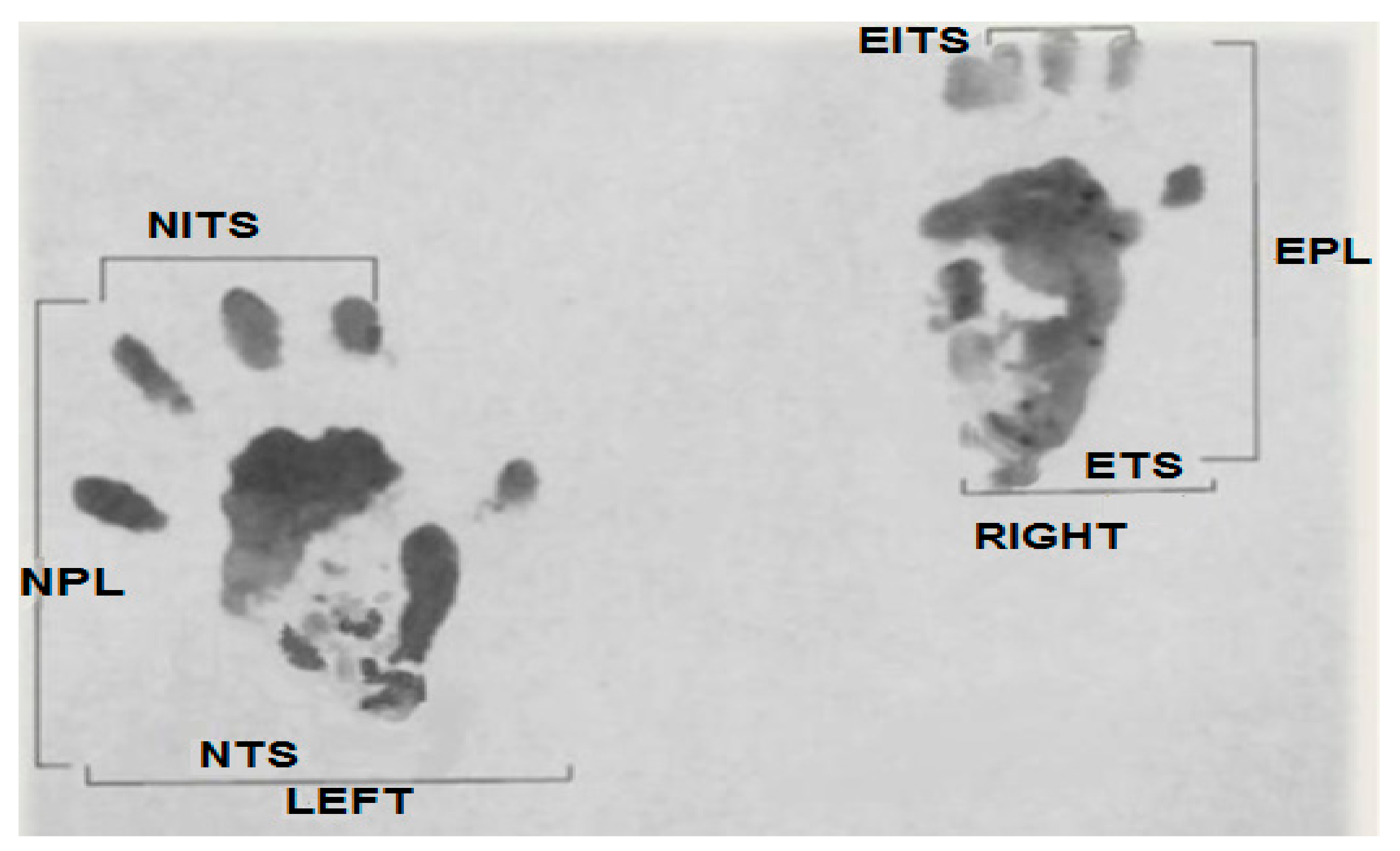
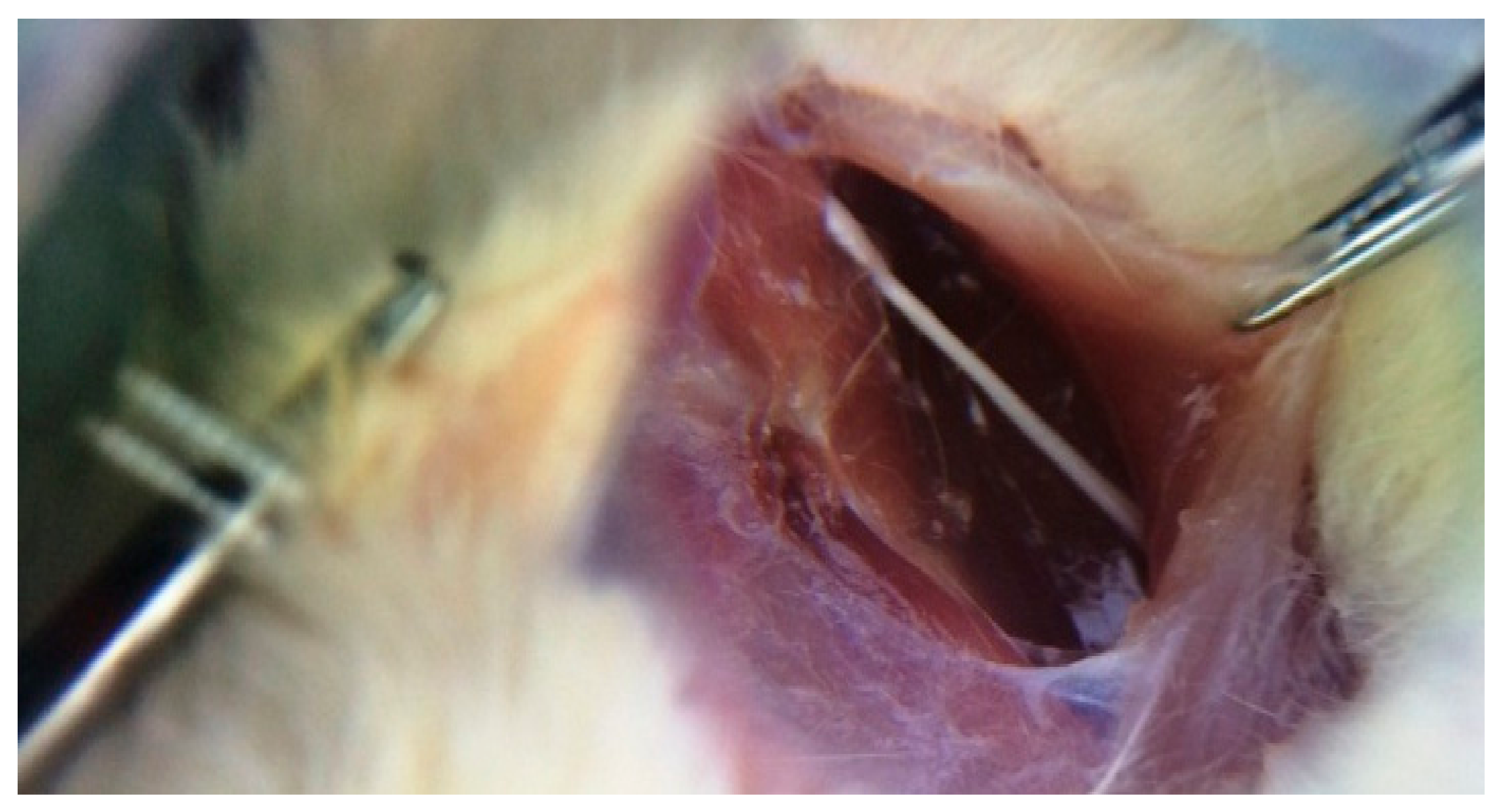
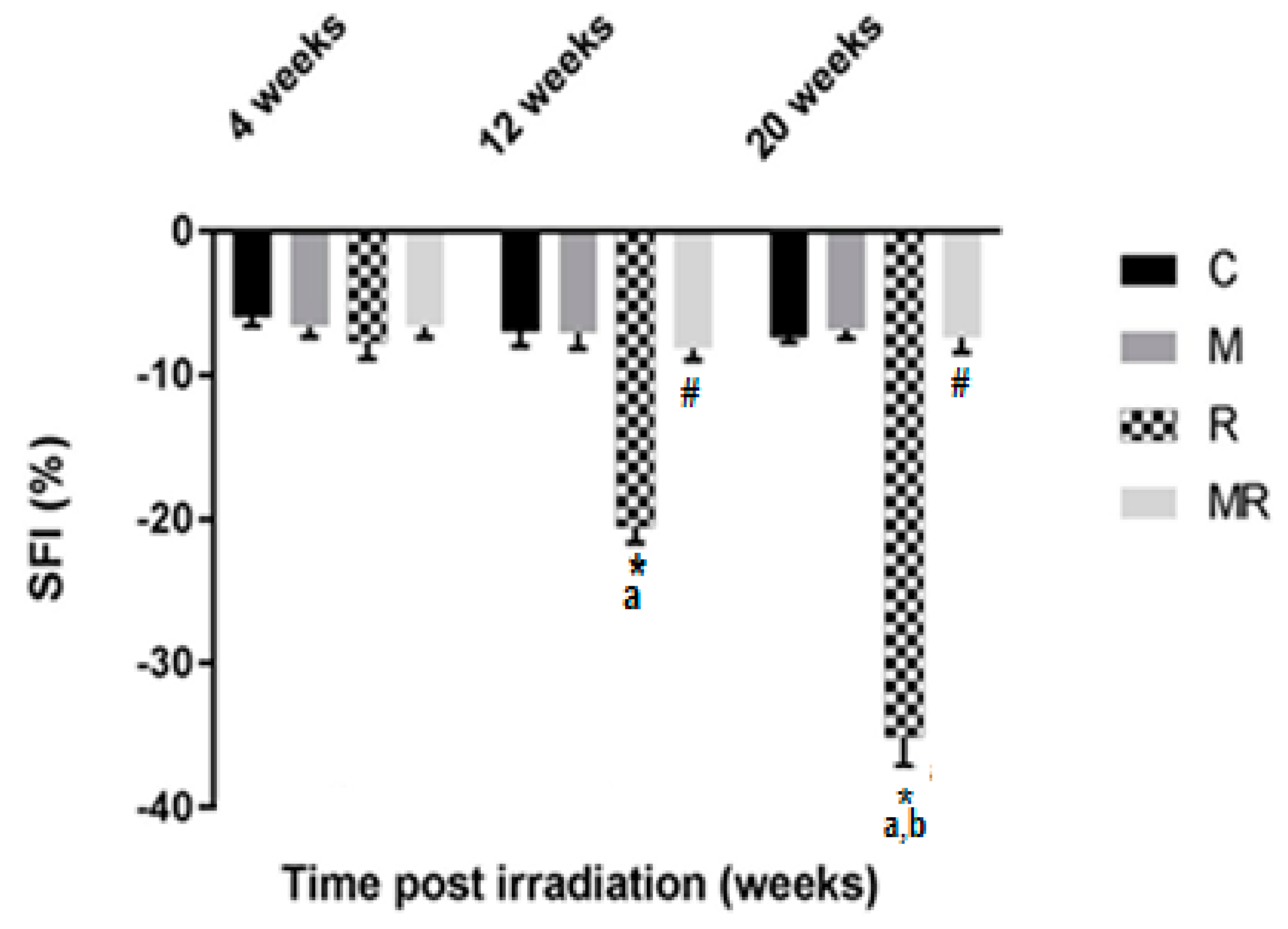


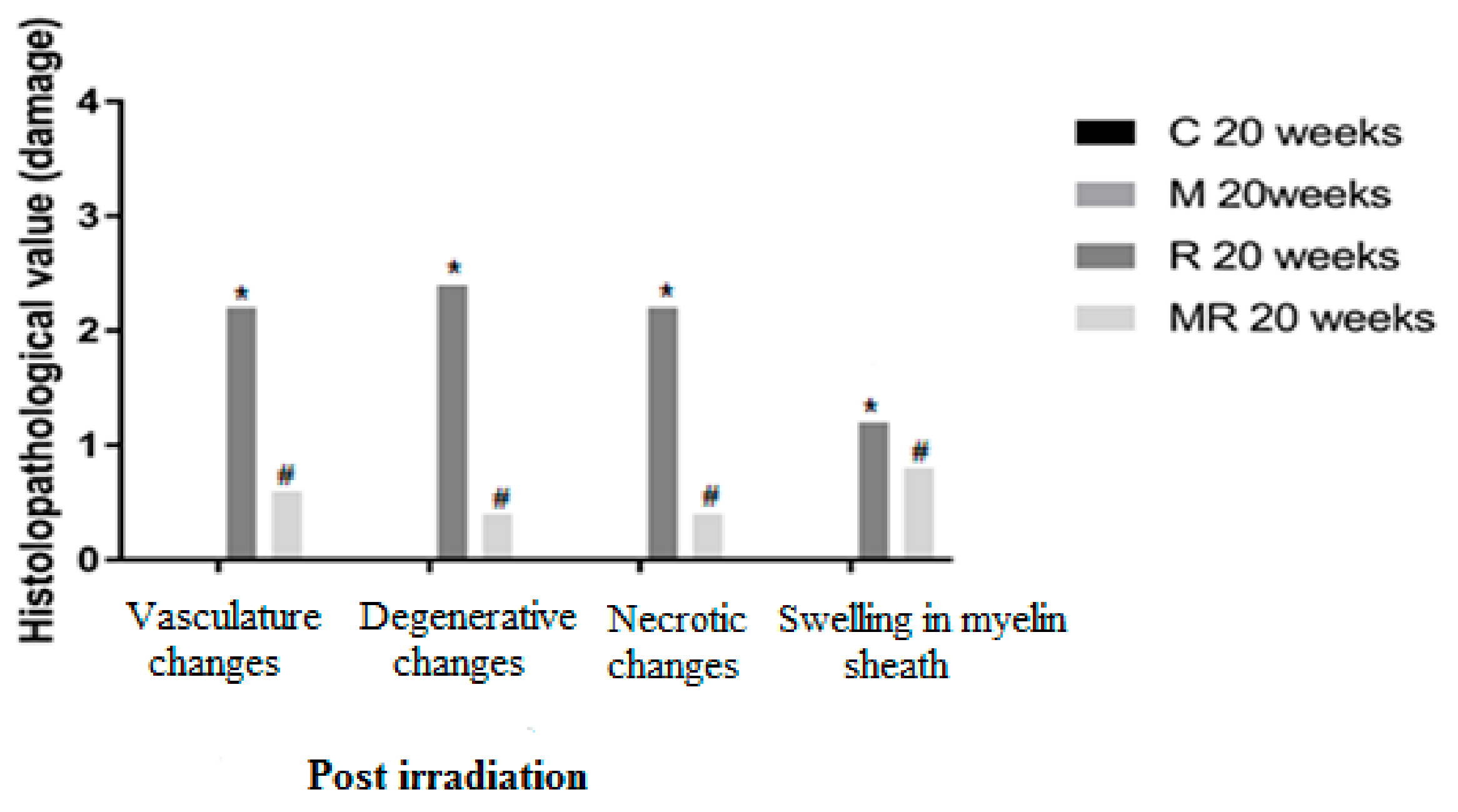

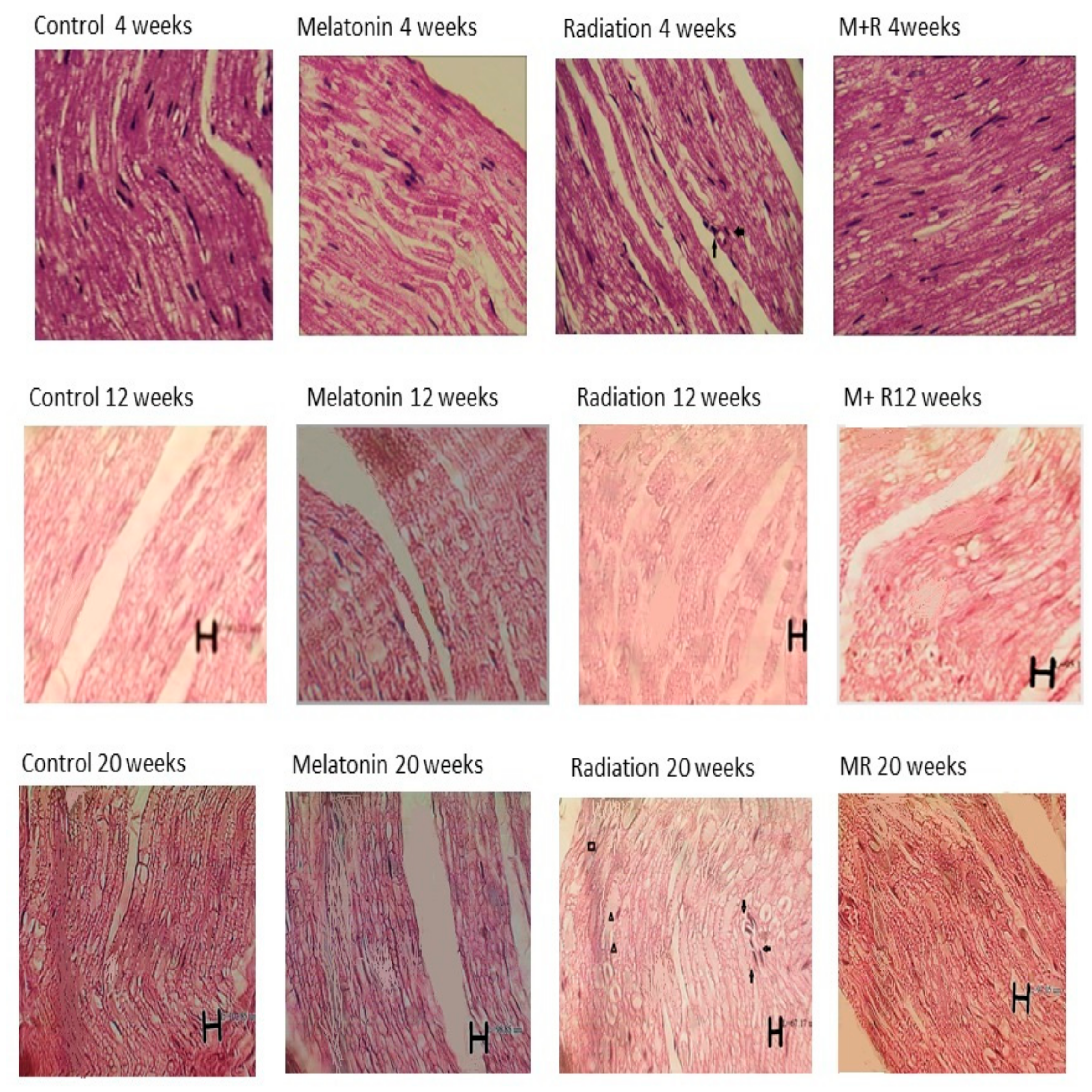
© 2019 by the authors. Licensee MDPI, Basel, Switzerland. This article is an open access article distributed under the terms and conditions of the Creative Commons Attribution (CC BY) license (http://creativecommons.org/licenses/by/4.0/).
Share and Cite
Shabeeb, D.; Musa, A.E.; Keshavarz, M.; Esmaely, F.; Hassanzadeh, G.; Shirazi, A.; Najafi, M. Histopathological and Functional Evaluation of Radiation-Induced Sciatic Nerve Damage: Melatonin as Radioprotector. Medicina 2019, 55, 502. https://doi.org/10.3390/medicina55080502
Shabeeb D, Musa AE, Keshavarz M, Esmaely F, Hassanzadeh G, Shirazi A, Najafi M. Histopathological and Functional Evaluation of Radiation-Induced Sciatic Nerve Damage: Melatonin as Radioprotector. Medicina. 2019; 55(8):502. https://doi.org/10.3390/medicina55080502
Chicago/Turabian StyleShabeeb, Dheyauldeen, Ahmed Eleojo Musa, Mansoor Keshavarz, Farid Esmaely, Gholamreza Hassanzadeh, Alireza Shirazi, and Masoud Najafi. 2019. "Histopathological and Functional Evaluation of Radiation-Induced Sciatic Nerve Damage: Melatonin as Radioprotector" Medicina 55, no. 8: 502. https://doi.org/10.3390/medicina55080502




